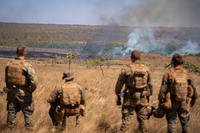PORTSMOUTH, Va. – The crew of the Coast Guard Cutter Legare returned to their homeport of Portsmouth August 19 following an 8-week patrol in the Caribbean Sea in support of the Joint Interagency Task Force South.
Upon leaving homeport in June, the Legare’s crew participated in Tailored Ship’s Training Availability , a biennial dedicated training period designed to assess the efficacy of the ship’s training teams as well as the ability of the crew to effectively perform across mission areas.
The next stop was Naval Station Mayport, Fla., to complete Airborne Use of Force training to practice coordinated ship, helicopter and cutter small boat operations, a critical skill-set in stopping go-fast vessels transporting drugs. Upon departing Mayport, one of the MH-65 Dolphin helicopter crews from the Coast Guard’s Helicopter Interdiction Tactical Squadron arrived on Legare for deployment, adding a crucial detection and interdiction asset.
While patrolling near Puerto Rico in early August, the Legare crew launched their embarked helicopter to locate a go-fast vessel. When the vessel refused to stop as directed by the helicopter crew, they used approved tactics, including disabling fire, to compel the vessel to stop. Legare’s small-boat crew boarded the disabled vessel and subsequently recovered 41 bales of cocaine from the water, with a total weight of more than 2,500 pounds and a wholesale value greater than $35 million. This seizure was the first in the Sector San Juan area of responsibility using the combined capabilities of HITRON helicopter and a major cutter.
“The entire patrol was a great success,” said Cmdr. Kevin King, the Legare’s commanding officer. “From challenging training opportunities which tested and prepared the crew, to interdicting a drug smuggling operation at sea, I couldn’t be more proud of the crew. They worked extremely hard, and more importantly, they worked together, to ensure our success as a team.”
Shortly before departing the Caribbean theatre, the Legare’s deployed HITRON helicopter participated in joint flight operations with an allied warship. By conducting such operations, units are able to test the interoperability of aircraft and ship capabilities. The crews of Legare, the helicopter and the allied vessel gained valuable training by conducting operations with unfamiliar platforms, helping to improve the overall interdiction posture of joint forces in the region.
The Legare is a 270-foot cutter homeported in Portsmouth. The vessel and crew execute maritime law enforcement, homeland security and search and rescue missions in support of Coast Guard operations throughout the Western Hemisphere.
This 23-year-old cutter, and the other 26 medium-endurance cutters are slated for replacement by a new class of cutters. The new Offshore Patrol Cutter will operate more than 50 miles from land, carrying out the Coast Guard's maritime security and safety activities in support of national interests. The OPC will be an economical, multi-mission ship, providing pursuit boat and helicopter capabilities and interoperability with other military and federal partners, superior to the cutters they replace. Equipped with modern sensors, the OPC will provide the enhanced surveillance necessary to detect threats far from U.S. shores and meet the demands of the Coast Guard’s homeland security, search and rescue, law enforcement and other vital missions.

























